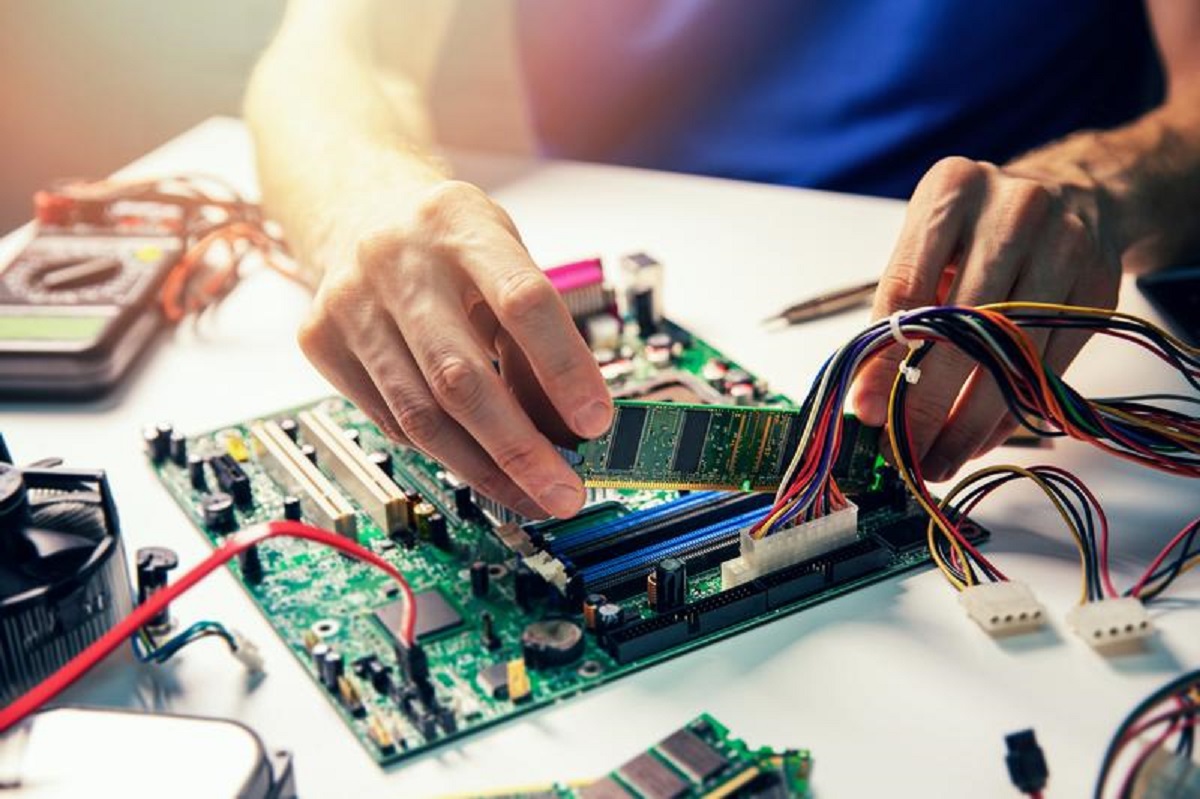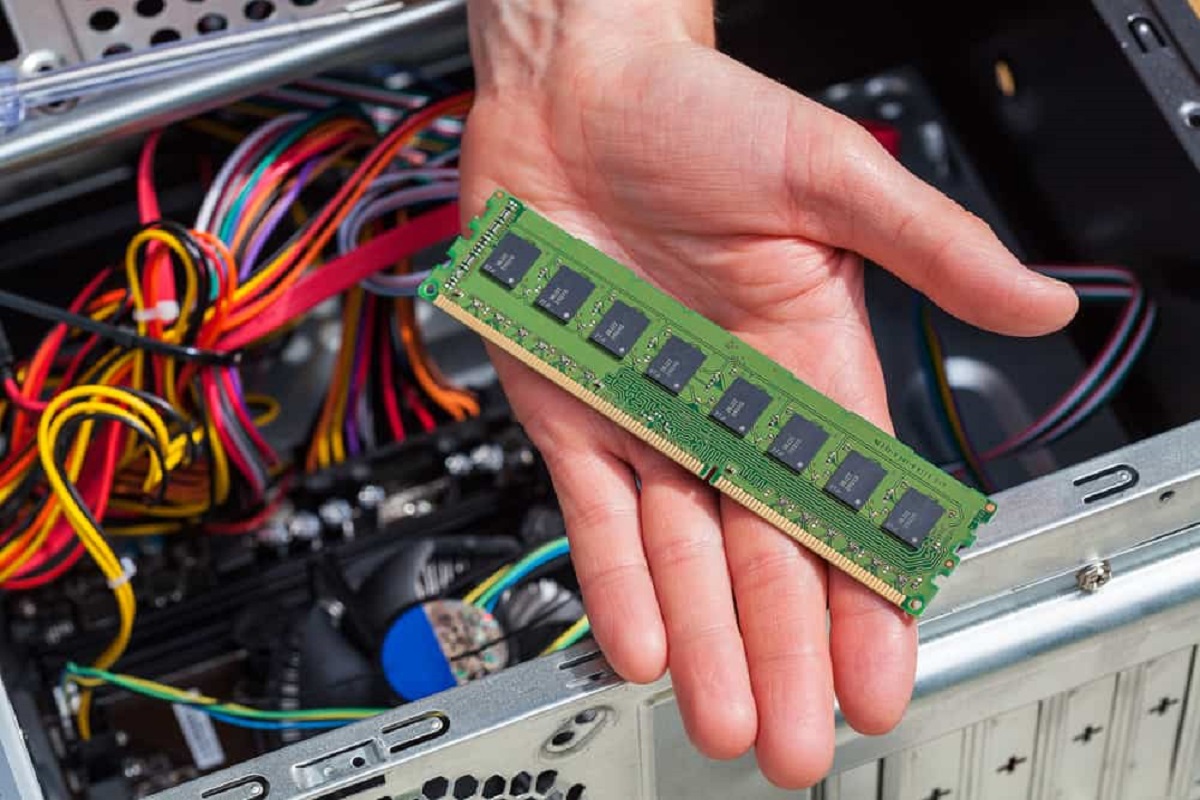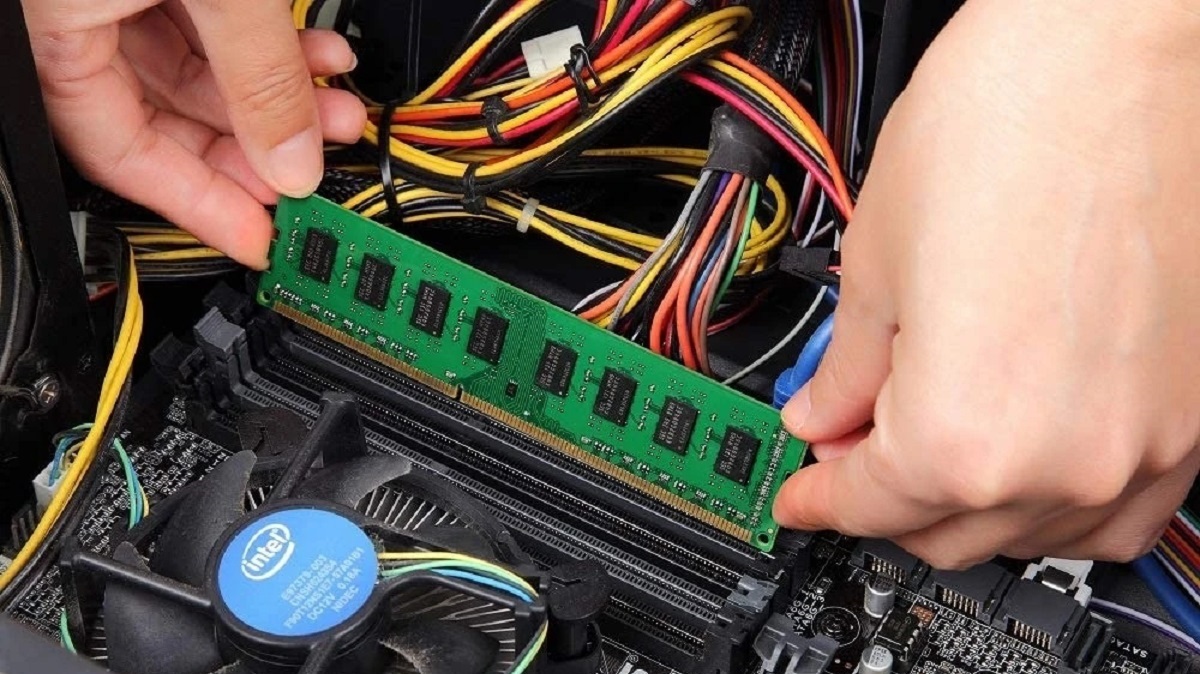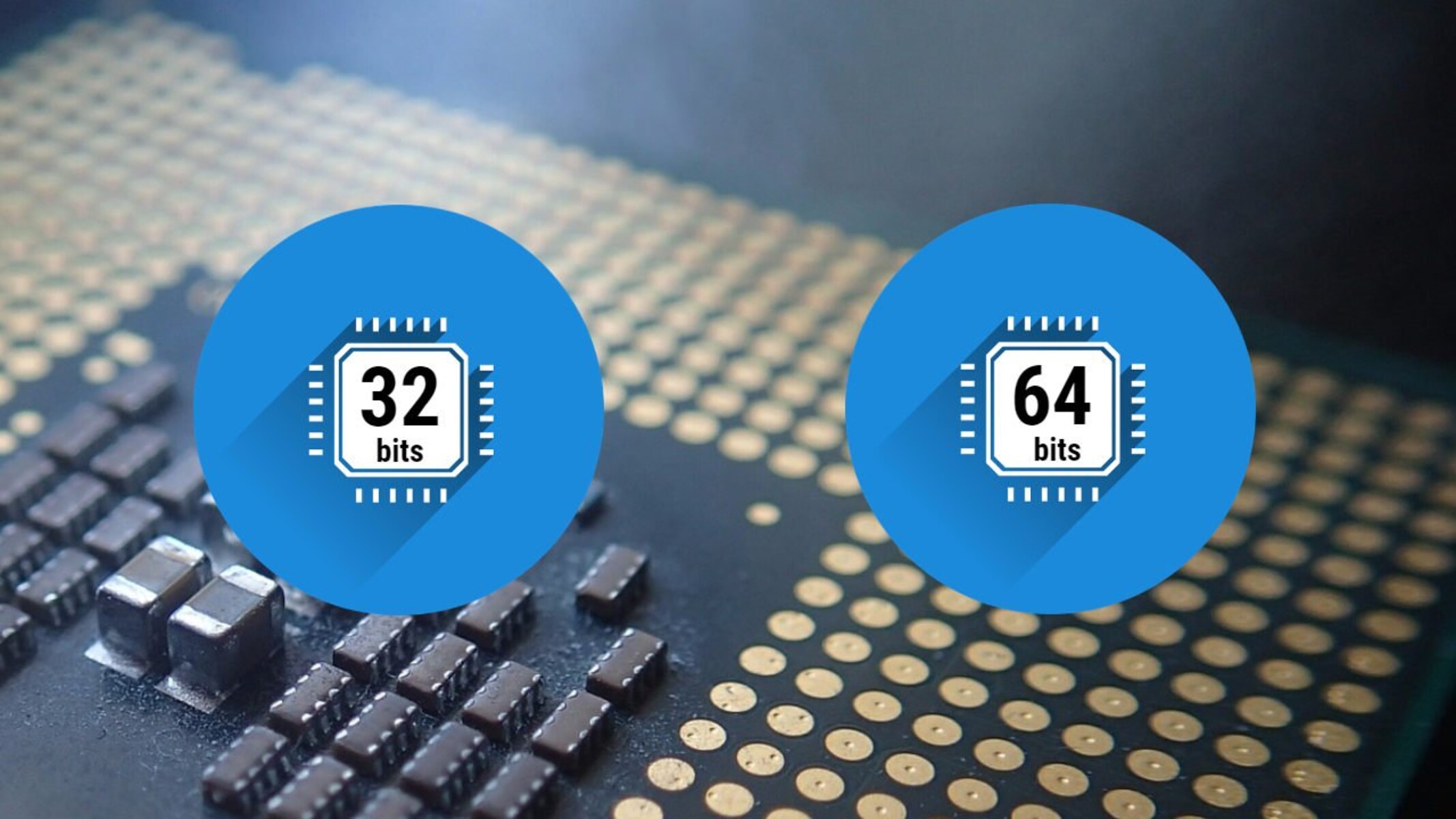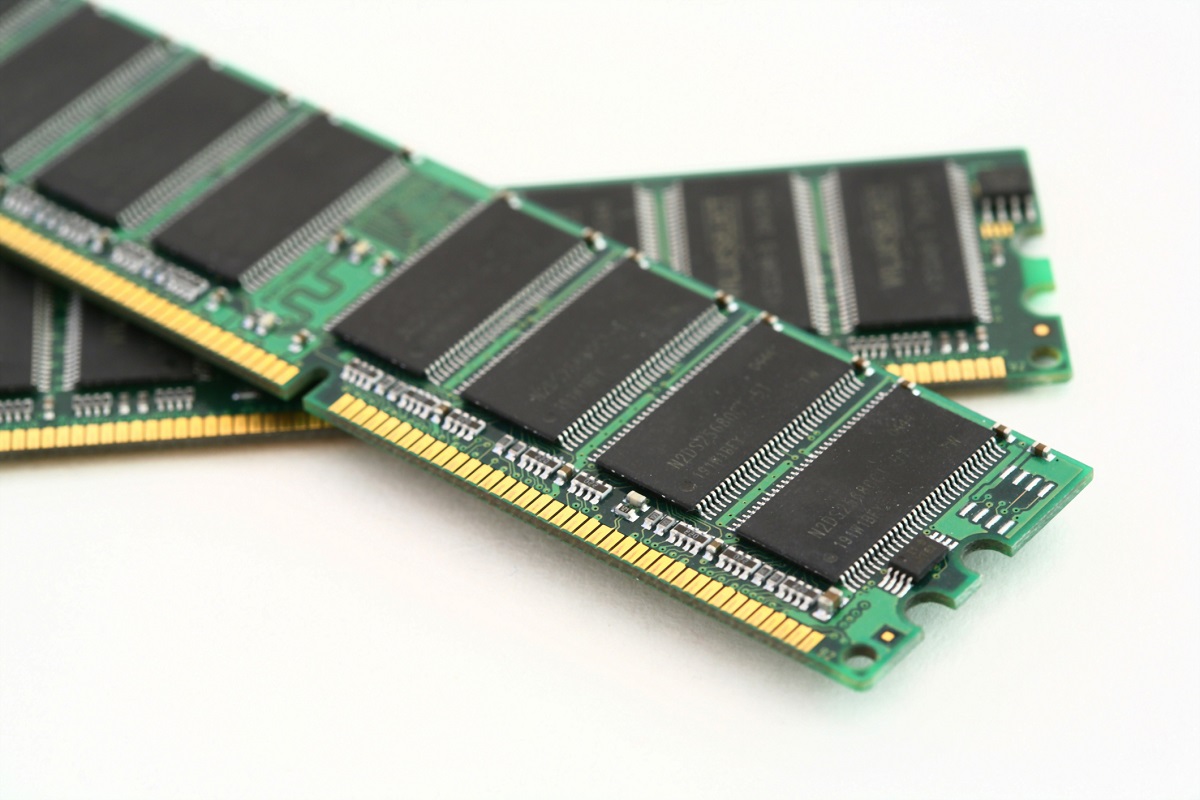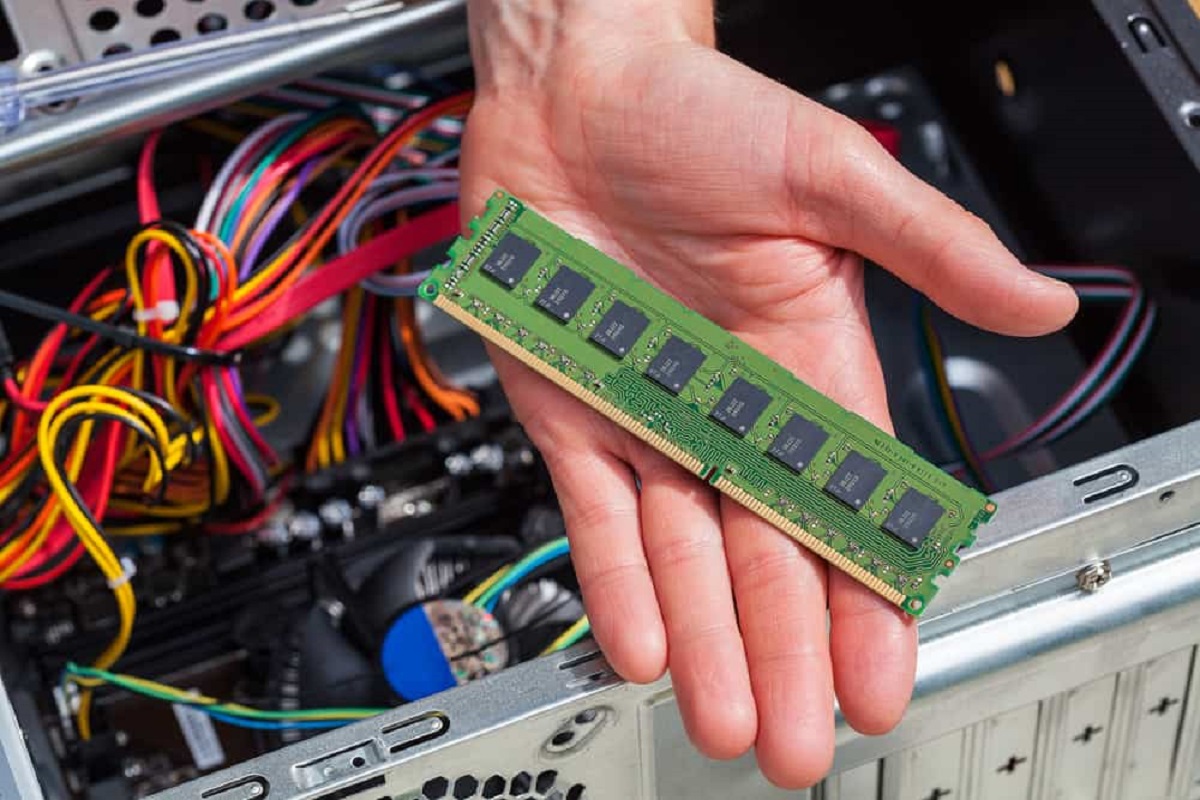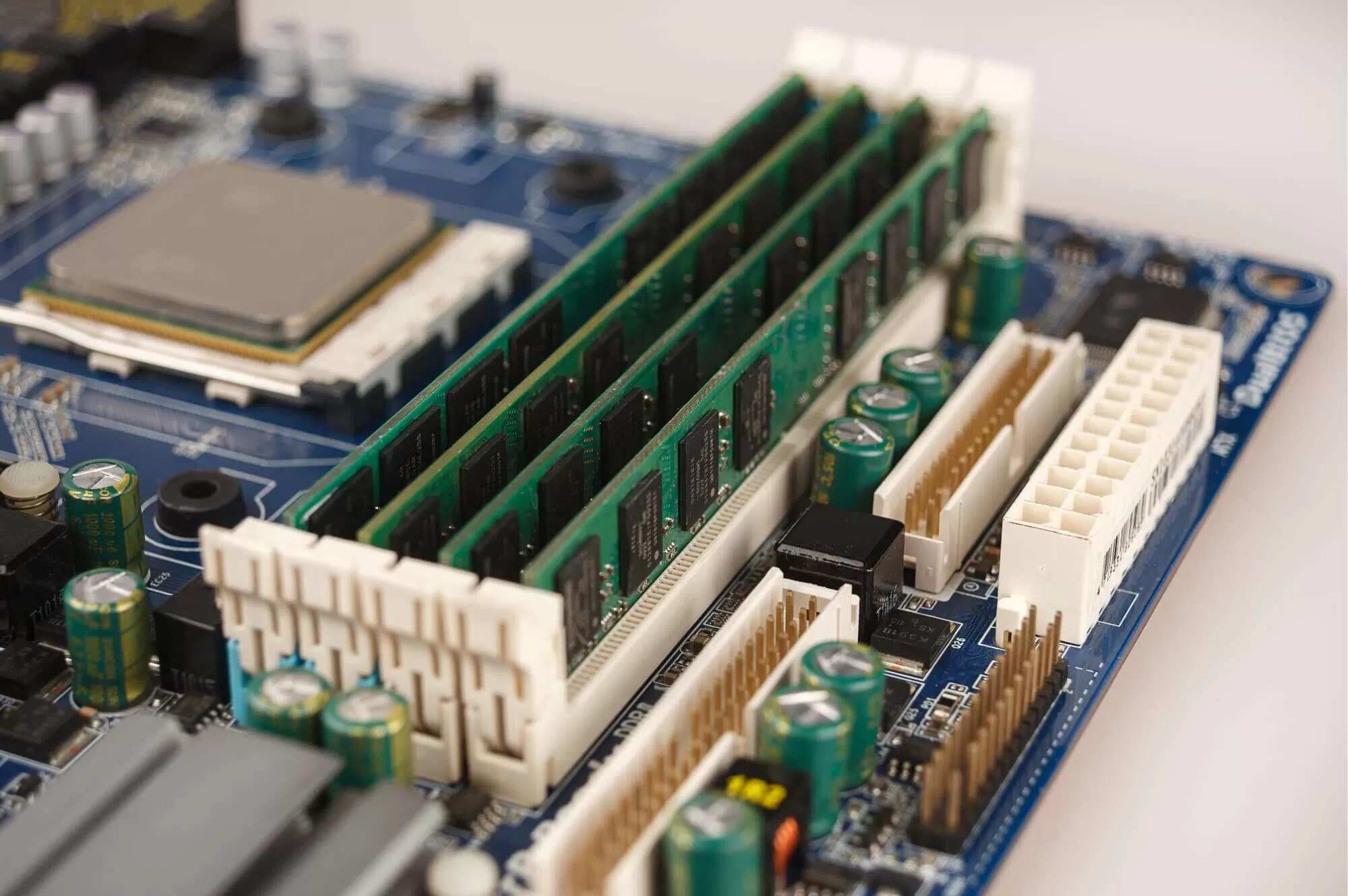Introduction
Welcome to the world of technology where performance and efficiency are of utmost importance. One vital component that plays a crucial role in the overall performance of a computer system is RAM, or Random Access Memory. Understanding RAM and its utilization is essential for optimizing system performance and troubleshooting any issues that may arise.
RAM is a type of computer memory that allows for rapid data access by the computer’s processor. It temporarily stores data that the processor needs to access frequently, such as running applications, operating system files, and other crucial data. RAM is like the working space of your computer, providing fast and temporary storage to handle multiple tasks simultaneously.
However, you may have encountered a perplexing situation where you notice that not all of your installed RAM is shown as usable. This can leave you wondering why you aren’t able to take full advantage of the memory you have installed. In this article, we will explore the reasons behind this issue and how to identify and resolve it.
Throughout this article, we will cover various potential causes, ranging from physical limitations and compatibility issues to BIOS settings and faulty RAM modules. We will also discuss how to check the amount of usable RAM on your system. By gaining a deeper understanding of these factors, you will be better equipped to address any issues and maximize the performance of your computer system.
What is RAM?
RAM, short for Random Access Memory, is a crucial component of any computer system. It is a type of volatile memory that temporarily holds data and instructions that the computer’s processor, or CPU, needs to access quickly. Unlike permanent storage devices such as hard drives or solid-state drives, RAM provides fast and temporary storage that allows for quick retrieval of data.
RAM is often referred to as the computer’s “short-term memory” as it plays a crucial role in multitasking and overall system performance. When you open programs or run applications on your computer, the necessary data is loaded into RAM to ensure fast and smooth processing. This temporary storage allows the processor to access the required information quickly, without constantly accessing the slower permanent storage devices.
RAM is designed to transfer data at high speeds, making it an essential element in enhancing the performance of your computer. The more RAM your system has, the more data it can store and access rapidly. This can lead to improved multitasking capabilities, faster program execution, and smoother overall system performance.
RAM comes in various types, such as DDR3, DDR4, and DDR5, each offering different speeds and capacities. The capacity of RAM is measured in gigabytes (GB) and can range from a few gigabytes to several terabytes, depending on your system’s capabilities.
It’s important to note that RAM is a volatile form of memory. This means that its contents are lost when the computer is powered off or restarted. Therefore, it is crucial to save your work and data to non-volatile storage such as hard drives or solid-state drives to avoid data loss.
In summary, RAM is a critical component that provides fast and temporary storage for the computer’s processor. It enables quick data retrieval, enhances multitasking capabilities, and contributes to overall system performance. Understanding RAM and its function is essential for optimizing the performance of your computer system.
How RAM works
RAM, or Random Access Memory, is a fundamental component of a computer system that plays a crucial role in its overall functionality. It serves as a temporary storage medium that allows the computer’s processor to quickly access information that is actively being used. Understanding how RAM works can help you grasp its importance in system performance.
When you turn on your computer and open applications or run programs, the CPU needs to access and process data to carry out the necessary tasks. This data is retrieved from the primary storage devices, such as hard drives or solid-state drives, and loaded into the RAM. The RAM acts as a bridge between the CPU and the permanent storage, providing fast and temporary storage to hold data that is actively being used.
RAM is organized into a series of memory cells, each capable of storing a specific amount of data. These cells are arranged in rows and columns, forming a grid-like structure. Each memory cell has a unique address, allowing the CPU to locate and retrieve data quickly.
When you launch an application or open a file, the required data is loaded from the storage device into specific memory cells in the RAM. The CPU can then access and manipulate this data at high speeds. This rapid retrieval and processing of data by the CPU contribute to the smooth functioning and responsiveness of your computer.
One of the key features of RAM is its random access capability, meaning that the CPU can access any memory cell in the RAM directly, regardless of its location in the grid. This allows for efficient data retrieval and reduces the need for the CPU to scan through large amounts of data to find what it needs.
It’s important to note that the size of RAM and its speed can greatly impact system performance. Larger RAM capacities allow for more data to be stored, reducing the need for the CPU to constantly access the slower permanent storage devices. Additionally, faster RAM speeds enable quicker data transfer between the RAM and the CPU, further enhancing performance.
In summary, RAM serves as the temporary storage medium that allows the CPU to quickly access and process data. By providing fast and direct access to actively used data, RAM plays a crucial role in optimizing system performance and ensuring a smooth user experience.
Understanding usable and non-usable RAM
When viewing the specifications of your computer system or checking the amount of RAM installed, you may have noticed that not all of the installed RAM is shown as usable. This discrepancy might leave you wondering about the reasons behind this distinction and how it affects the overall performance of your computer.
Usable RAM refers to the portion of installed memory that the operating system recognizes and is available for use by applications and processes. It is the memory that can be accessed and utilized by the CPU to store and manipulate data. On the other hand, non-usable RAM, sometimes referred to as reserved or hardware-reserved RAM, is the portion of memory that is allocated and reserved for specific system functions and hardware components.
Several factors can contribute to the differentiation between usable and non-usable RAM. These factors include physical limitations, compatibility issues, BIOS settings, memory-mapped I/O, faulty RAM modules, and system limitations.
Physical limitations can play a role in determining the usable RAM capacity. For example, 32-bit operating systems have a limitation which prevents them from utilizing more than 4GB of RAM, regardless of how much is installed. To take full advantage of larger RAM capacities, a 64-bit operating system must be used.
Compatibility issues can also affect the usable RAM. Different motherboard models or CPU architectures may have limitations on the maximum amount of supported RAM. If your system exceeds these limitations, the excess RAM may not be recognized as usable by the operating system.
BIOS settings can also impact the usable RAM. In some cases, the BIOS may have settings that limit the amount of RAM that can be utilized. Ensuring that the BIOS settings are properly configured is important for maximizing the available RAM on your system.
Memory-mapped I/O is another factor that affects usable RAM. Some components, such as graphics cards or network adapters, may use a portion of the system’s memory for direct access and data transfers. This memory is typically marked as non-usable as it is reserved for these specific hardware functions.
Faulty RAM modules can also result in non-usable RAM. If a module is defective or fails, it may not be recognized by the system, leading to a reduction in usable memory. To identify faulty RAM, diagnostic tools can be used to test the modules and determine if replacement is necessary.
Lastly, system limitations, such as the operating system’s memory management capabilities, can impact usable RAM. Some operating systems may impose limits on the amount of RAM that can be utilized, even if the hardware supports larger capacities.
Understanding the distinction between usable and non-usable RAM is crucial for managing and optimizing system performance. By identifying the factors that contribute to non-usable RAM, you can take appropriate steps to maximize the available RAM and ensure your computer operates at its best capacity.
Why is some of my RAM not usable?
It can be frustrating to discover that not all of your installed RAM is being recognized as usable by your computer system. There are several potential reasons behind this issue, ranging from physical limitations and compatibility issues to BIOS settings and faulty RAM modules. Understanding these factors can help you identify and resolve the problem.
One common reason for non-usable RAM is physical limitations. For instance, if you are using a 32-bit operating system, it has a maximum addressable memory limit of 4GB. This means that even if you have more than 4GB of RAM installed, the operating system will only recognize and utilize up to this limit. To access larger RAM capacities, you would need to upgrade to a 64-bit operating system, which supports much higher memory limits.
Compatibility issues can also lead to non-usable RAM. Different motherboard models or CPU architectures may have limitations on the maximum supported RAM. If your installed RAM exceeds these limitations, the excess memory may not be recognized as usable by the operating system. In such cases, referring to the specifications of your motherboard or consulting with the manufacturer can help determine the supported maximum RAM capacity.
Another factor to consider is BIOS settings. The settings in the computer’s BIOS (Basic Input/Output System) can impact the amount of usable RAM. Certain BIOS configurations may restrict the amount of RAM that can be utilized by the system. Checking and adjusting these settings, if necessary, can help maximize the usable RAM on your system.
Memory-mapped I/O is another consideration. Some hardware components, such as graphics cards or network adapters, use a portion of the system’s memory for direct access and data transfers. This memory is marked as non-usable as it is reserved for these specific hardware functions. While this allocation is necessary for proper device operation, it reduces the overall amount of usable RAM.
Faulty RAM modules can also result in non-usable RAM. If a module is defective or fails, it may not be recognized by the system, leading to a reduction in usable memory. To determine if faulty RAM is the issue, diagnostic tools can be used to test the modules and identify any problems. If faulty RAM is detected, replacing the malfunctioning module can restore the full amount of usable RAM.
Lastly, system limitations can affect the usable RAM. Certain operating systems may impose memory limits, even if the hardware supports larger capacities. For example, some versions of Windows may have limitations on the amount of RAM that can be utilized based on the edition. Upgrading to a more advanced edition or switching to a different operating system may provide access to more usable RAM.
By understanding these potential reasons for non-usable RAM, you can take the necessary steps to resolve the issue. Whether it involves upgrading the operating system, adjusting BIOS settings, replacing faulty RAM modules, or considering hardware compatibility, addressing the underlying causes will help you optimize the usage of your installed RAM and ensure your computer performs at its best.
Physical limitations
When it comes to the amount of usable RAM on your computer system, physical limitations play a significant role. These limitations can impact the maximum amount of RAM that can be recognized and utilized by the operating system. Understanding these physical limitations is crucial for optimizing system performance and avoiding any unexpected surprises.
One common physical limitation is related to the use of a 32-bit operating system. The 32-bit architecture has a maximum addressable memory limit of 4GB. This means that regardless of how much RAM you have installed, the operating system can only recognize and utilize up to 4GB. This is due to the fact that a 32-bit system uses 32 bits to address memory, resulting in a maximum addressable range of 4GB. If you want to take full advantage of larger RAM capacities, it is necessary to upgrade to a 64-bit operating system that supports much higher memory limits. A 64-bit operating system can address up to 18.4 million terabytes of RAM, allowing for the utilization of larger amounts of memory.
Another physical limitation to consider is the maximum supported RAM capacity of your motherboard or CPU. Different motherboard models and CPU architectures have specific limitations on the amount of RAM they can support. These limitations are determined by the physical capabilities of the hardware. If you install RAM that exceeds the supported capacity, the excess memory will not be recognized as usable by the operating system. To ensure compatibility, it is important to consult the specifications of your motherboard or CPU to determine the maximum supported RAM capacity.
Additionally, the physical design of your computer may impose limitations on the number of RAM slots available. This can affect the maximum amount of RAM that can be installed and utilized. Some systems may have a limited number of slots, restricting the overall RAM capacity. It is essential to check the number of available slots and the maximum capacity per slot on your motherboard to optimize your RAM configuration.
Furthermore, the type of RAM technology you are using can also impact physical limitations. Different RAM technologies, such as DDR3, DDR4, and DDR5, have varying maximum supported capacities. For example, older DDR3 technology typically had a lower maximum capacity compared to the more recent DDR4 and DDR5 technologies. It’s crucial to ensure that your motherboard and CPU support the specific RAM technology you are using to avoid any limitations.
Understanding and considering these physical limitations can help you make informed decisions about upgrading and optimizing your RAM configuration. Whether it involves upgrading to a 64-bit operating system, verifying motherboard and CPU specifications, or choosing the appropriate RAM technology, addressing these physical constraints will ensure that your computer system operates at its best capacity.
Compatibility issues
When it comes to RAM utilization on a computer system, compatibility is a crucial factor that can impact the amount of usable RAM. Various compatibility issues can arise, preventing the system from recognizing and utilizing the full capacity of the installed RAM modules. Understanding these compatibility issues is essential for troubleshooting and optimizing RAM performance on your computer.
One common compatibility issue is related to the motherboard and CPU architecture. Every motherboard and CPU combination has specific limitations on the maximum amount of RAM they can support. These limitations are determined by the physical design and specifications of the hardware. If you install RAM modules that exceed the supported capacity of your motherboard and CPU, the excess memory will not be recognized by the system. To ensure compatibility, it is important to refer to the documentation and specifications of your motherboard and CPU to determine the maximum supported RAM capacity.
It’s also essential to consider the type and speed of RAM modules you are using. RAM modules come in different formats, such as DDR3, DDR4, and DDR5, each with a specific design and speed rating. While it may be physically possible to install different types of RAM modules on your motherboard, the system may not be able to utilize them all effectively. Mixing different types and speeds of RAM can result in compatibility issues, causing the system to only recognize and use a portion of the installed memory. To avoid these problems, it is recommended to use RAM modules that match the specifications and requirements of your motherboard and CPU.
Another compatibility issue to consider is the operating system’s capabilities. Older operating systems may have limitations on the maximum amount of RAM they can support, particularly in 32-bit versions. For example, a 32-bit operating system can only address up to 4GB of RAM, regardless of the installed capacity. To utilize larger RAM capacities fully, it is necessary to upgrade to a 64-bit operating system, which supports much higher memory limits.
Updating the system’s BIOS (Basic Input/Output System) can also resolve compatibility issues. BIOS updates often include improvements and fixes that enhance RAM compatibility and stability. Checking for BIOS updates from the motherboard manufacturer’s website and applying the latest version can help ensure better compatibility and utilization of the installed RAM.
In some cases, faulty RAM modules can also cause compatibility issues. If one or more RAM modules are defective or not functioning correctly, the system may not recognize them, resulting in reduced usable memory. Performing diagnostic tests on the RAM modules using hardware diagnostic tools can help identify and isolate any faulty modules. If faulty RAM is detected, replacing the defective modules can restore the full amount of usable RAM.
By considering these compatibility issues and taking appropriate measures, such as checking hardware specifications, updating the BIOS, and ensuring RAM module compatibility, you can optimize the utilization of RAM on your system. Mismatched or incompatible RAM configurations can lead to decreased performance, while addressing compatibility concerns will contribute to a stable and efficient computer system.
BIOS settings
Your computer’s BIOS (Basic Input/Output System) contains a variety of settings that can impact the utilization of RAM. These settings can affect the amount of usable RAM recognized by the system and its overall performance. Understanding and adjusting the BIOS settings appropriately can help optimize RAM utilization and enhance your computer system’s efficiency.
One vital BIOS setting related to RAM is called “Memory Remapping” or “Memory Hole Remapping.” This setting enables the system to utilize RAM installed beyond the 4GB limit imposed by the 32-bit operating systems. By enabling memory remapping, the system can map the physical addresses of the additional RAM and make them accessible to the operating system. This setting is particularly important for systems running 64-bit operating systems or those with large RAM capacities installed.
Another BIOS setting to consider is the “Memory Frequency” or “DRAM Frequency.” This setting determines the speed at which the RAM modules operate. By matching the memory frequency setting with the actual speed of your RAM modules, you can ensure optimal performance. It is important to note that setting the memory frequency too high may result in system instability, while setting it too low may underutilize the full potential of your RAM’s speed. Consulting the specifications of your RAM modules and adjusting the memory frequency accordingly can help maximize performance while maintaining stability.
Some BIOS settings may also allow you to configure the timing parameters of the RAM modules, such as CAS latency, RAS to CAS delay, and others. These settings, often referred to as “DRAM Timings” or “Memory Timings,” control the responsiveness and efficiency of the RAM modules. Optimizing these timings can result in improved RAM performance and overall system responsiveness. However, it is crucial to note that adjusting these settings should be done carefully, as incorrect settings can cause system instability. Referencing the specifications of your RAM modules and consulting reliable resources can provide guidance on optimal timing configurations.
Additionally, the “Dual-Channel Mode” or “Memory Interleaving” setting in the BIOS can impact RAM performance. If your system supports dual-channel memory, enabling this setting allows the RAM to work in parallel, increasing the memory bandwidth and enhancing performance. This setting often requires matching RAM modules and properly populating the memory slots according to the motherboard’s guidelines. Ensuring the dual-channel mode is enabled and that the RAM modules are arranged correctly can optimize the utilization of RAM.
It is crucial to note that accessing and adjusting BIOS settings requires caution as changes made in the BIOS can have significant impacts on system stability and performance. Before making any modifications, it is recommended to consult the motherboard’s manual or website for specific instructions and recommendations. Improper BIOS settings can lead to system instability or even prevent the computer from booting properly. It is advisable to document the original settings or take note of any changes made to ensure easy restoration to a stable configuration if needed.
Understanding and properly configuring BIOS settings related to RAM can help optimize the utilization and performance of your computer’s memory. By adjusting settings such as memory remapping, memory frequency, timing parameters, and dual-channel mode, you can enhance RAM performance and overall system efficiency. However, exercise caution and ensure that any modifications made to the BIOS align with the specifications and requirements of your hardware.
Memory-mapped I/O
Memory-mapped I/O (Input/Output) is a technique used in computer systems to allow hardware components to access and communicate with the system’s memory directly. This technique enables efficient data transfer and communication between the CPU and various hardware devices. However, memory-mapped I/O can also impact the amount of usable RAM in a computer system.
When a hardware device, such as a graphics card or network adapter, utilizes memory-mapped I/O, it reserves a portion of the system’s memory for direct access and data transfers. This reserved memory is typically marked as non-usable by the system, as it is dedicated to specific hardware functions. By allocating this memory for direct access, the hardware device can operate more efficiently and communicate with the CPU without going through the traditional I/O pathways, resulting in faster data transfers and enhanced performance.
Memory-mapped I/O can impact the available RAM by reducing the overall amount that is recognized as usable by the operating system. The amount of memory reserved for memory-mapped I/O can vary depending on the hardware device and its requirements. In some cases, the impact on usable RAM may be negligible, while in others, it can be more significant.
It’s important to note that the memory reserved for memory-mapped I/O is typically a fixed allocation and cannot be adjusted by the user. This means that the amount of non-usable RAM dedicated to memory-mapped I/O is determined by the hardware device and its specifications. The exact amount reserved can vary depending on the specific hardware components in your system.
While memory-mapped I/O can reduce the available RAM, it is important to recognize its significance for hardware performance. The direct access to memory through memory-mapped I/O allows devices like graphics cards to store and retrieve data efficiently, enabling smooth graphics rendering and intensive tasks. Similarly, network adapters benefit from memory-mapped I/O for rapid data transfers.
To optimize RAM utilization in systems with memory-mapped I/O, it is advisable to install RAM modules with larger capacities to compensate for the reserved memory. This ensures that sufficient usable memory is available for applications and processes while still allowing the hardware components to utilize memory-mapped I/O for enhanced performance.
In summary, memory-mapped I/O is a technique that allows hardware devices to directly access and communicate with a computer system’s memory. While it contributes to improved device performance, memory-mapped I/O reserves a portion of the system’s memory, reducing the overall amount recognized as usable RAM. Understanding the impact of memory-mapped I/O on RAM utilization is essential for optimizing system performance and ensuring a balance between efficient hardware operations and available system memory.
Faulty RAM modules
Faulty RAM modules can be a significant cause of non-usable RAM in a computer system. When one or more RAM modules become defective or fail, they can prevent the system from recognizing and utilizing the full capacity of installed memory. Understanding the impact of faulty RAM and addressing the issue promptly is crucial for optimizing system performance.
There are several indicators that can help identify faulty RAM modules. System crashes, random errors, and frequent application crashes are common signs of problematic RAM. In some cases, the system may not even boot or may experience a series of unstable behaviors. If you suspect faulty RAM, running a diagnostic program specifically designed to test RAM can help pinpoint any issues.
When faulty RAM modules are present, they can result in reduced usable memory or make the system unstable as it attempts to access faulty memory addresses. In such cases, the system might automatically mark the faulty memory as non-usable to avoid potential crashes or errors. This can result in a decrease in the total amount of usable RAM recognized by the operating system.
To address faulty RAM modules, the first step is to identify which specific module or modules are causing the issue. Many diagnostic tools are available that can help perform tests on the RAM modules individually or in combination. By running these tests, you can identify the faulty modules and single them out for replacement.
Once you have identified the problematic RAM modules, the next step is to replace them. Most RAM modules come with warranties, and if the faulty modules are still within the warranty period, you can contact the manufacturer for a replacement. Removing the faulty modules from the system and installing the new ones will restore the full amount of usable RAM.
It is important to ensure that the replacement RAM modules are compatible with your system. Matching the specifications, such as capacity, speed, and technology (DDR3, DDR4, etc.), of the new RAM modules to the original ones will help maintain system compatibility and stability.
In some cases, faulty RAM modules may be caused by issues such as poor connections or dirty contacts. Before assuming the modules are defective, it is worthwhile to try reseating them in their slots, ensuring a secure and clean connection. Cleaning the contacts using an alcohol pad or a gentle eraser can also help eliminate any potential issues caused by debris or oxidation.
Resolving faulty RAM issues requires prompt action to restore optimal system performance. By identifying and replacing the faulty modules, you can ensure that the system recognizes and utilizes the full capacity of your installed RAM. Regularly monitoring your system’s behavior and running diagnostic tests can help detect potential RAM problems early and prevent further complications.
System limitations
System limitations can contribute to non-usable RAM, affecting the amount of memory that is recognized and utilized by the operating system. These limitations can arise from various factors, such as the operating system’s memory management capabilities, licensing restrictions, or even software limitations. Understanding these system limitations is crucial for optimizing RAM utilization and ensuring efficient system performance.
One common system limitation is related to the memory management capabilities of the operating system. Different operating systems have varying limits on the maximum amount of RAM they can support. For instance, some versions of Windows, such as Windows 10 Home, have memory limitations that may restrict the amount of RAM that can be utilized. Upgrading to a more advanced edition, such as Windows 10 Pro or Windows Server editions, may provide access to higher memory limits and enable the utilization of larger RAM capacities.
Licensing restrictions can also affect the amount of usable RAM in some situations. Some software licenses may impose limitations on the maximum amount of RAM that can be utilized. This can be particularly relevant in virtualization environments where the licensing terms may restrict the amount of RAM allocated to each virtual machine instance. Understanding the licensing terms and restrictions associated with the software being used is important for optimizing RAM utilization within the limits of the license.
Software limitations can also impact the utilization of RAM. Some applications or programs may have specific memory requirements or limitations that prevent them from utilizing large amounts of RAM effectively. This can result in the operating system recognizing the installed RAM but only utilizing a portion of it due to software limitations. Checking the documentation or support resources for specific software applications can provide insights into any RAM limitations to be aware of.
In some cases, the hardware architecture itself may impose limitations on RAM utilization. For example, certain devices or components built into the system, such as integrated graphics processors, may reserve a portion of the system’s memory for their own operation. This reserved memory is typically marked as non-usable by the operating system and reduces the overall amount of usable RAM. Identifying and understanding the hardware’s limitations related to RAM utilization can help manage expectations and optimize system performance.
To maximize RAM utilization within system limitations, it is important to keep the operating system and software up to date. Updates often include optimizations and bug fixes that can enhance memory management and improve overall system performance. Additionally, consulting documentation, user forums, or technical support resources specific to your operating system, applications, and hardware can provide valuable insights and guidance on optimizing RAM utilization.
By understanding and working within the system limitations, you can make informed decisions to optimize RAM utilization and ensure efficient system performance. By staying informed about the operating system’s memory management capabilities, software licensing restrictions, and hardware-specific limitations, you can effectively manage RAM resources and tailor your system’s configuration to meet your specific needs.
How to check usable RAM
Checking the amount of usable RAM on your computer system is a straightforward process that allows you to ensure that your system is recognizing and utilizing the installed memory effectively. There are several methods you can use to check the amount of usable RAM, both built-in to the operating system and with the help of third-party tools.
One of the most common ways to check the amount of usable RAM is by using the built-in system information tools provided by the operating system. On Windows systems, you can use the Task Manager to view the amount of available and used RAM. Simply right-click on the taskbar and select “Task Manager,” then navigate to the “Performance” tab and look for the “Memory” section. This will display the total amount of RAM installed on your system, as well as the amount of RAM currently in use.
Another built-in tool on Windows systems is the System Information utility. You can access this tool by typing “msinfo32” in the Run dialog box (Win + R) or searching for “System Information” in the Start menu. In the System Information window, navigate to the “System Summary” section, and you will find information about your system’s installed RAM, including the total physical memory and the amount of usable memory.
On Mac systems, you can check the usable RAM by clicking on the Apple logo in the top menu bar, selecting “About This Mac,” and then clicking on the “Memory” tab. This will display information about the total memory and the current memory usage.
Third-party software tools can also be used to check the amount of usable RAM on your system. These tools often provide more detailed information and additional features. Some popular third-party options for Windows include CPU-Z and HWiNFO. These tools provide comprehensive system information, including details about the installed RAM and its utilization.
For Linux users, the free command-line tool “free” can be utilized to check the amount of usable RAM. Open a terminal and type “free -h” to display a summary of the available, used, and total RAM on your system.
It is important to note that when checking the amount of usable RAM, you may see that it is slightly lower than the total installed RAM. This is because a portion of the memory is reserved for system operations, such as hardware support or system processes. The reserved memory is marked as non-usable and is necessary for the proper functioning of your system.
By using these built-in tools or third-party software, you can easily check the amount of usable RAM on your computer system. Regularly monitoring the RAM utilization can help you identify any issues, such as insufficient memory for intensive tasks, and make informed decisions about upgrades or optimizing system performance.
Conclusion
Understanding the concept of usable and non-usable RAM is crucial for maximizing the performance of your computer system. Throughout this article, we have explored various factors that can contribute to non-usable RAM, including physical limitations, compatibility issues, BIOS settings, memory-mapped I/O, faulty RAM modules, and system limitations. By comprehending these factors, you can effectively troubleshoot and optimize your RAM utilization.
Physical limitations, such as operating system restrictions and hardware compatibility, can impact the maximum amount of usable RAM. Upgrading to a 64-bit operating system and ensuring compatibility between the motherboard, CPU, and RAM modules are essential for maximizing available memory.
BIOS settings play a vital role in determining the amount of usable RAM. Enabling memory remapping, configuring memory frequency and timings, and optimizing dual-channel mode can enhance RAM performance and utilization.
Memory-mapped I/O, which reserves a portion of the memory for hardware devices, can reduce the amount of usable RAM. While this allocation benefits device performance, compensating for the reserved memory with larger RAM capacities is crucial.
Faulty RAM modules can result in non-usable RAM. Identifying and replacing defective modules through diagnostic tools ensures optimal RAM utilization and system stability.
System limitations, including memory management capabilities and software restrictions, can affect usable RAM. Upgrading to a compatible operating system and staying aware of software limitations are necessary for optimizing RAM utilization.
Checking the amount of usable RAM can be done through built-in system information tools or third-party software. Regular monitoring of RAM utilization helps identify any issues and allows informed decisions for upgrades or system optimization.
By considering these factors and taking appropriate measures, you can maximize the utilization of available RAM and ensure optimal system performance. Keeping your computer system running smoothly with efficient RAM utilization enables you to tackle demanding tasks, run multiple applications, and enhance overall productivity and enjoyment of your computing experience.









